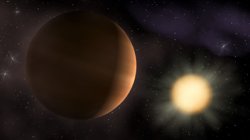Catching up with some older items, I want to be sure to cover a planet recently discovered in the constellation Hercules, because it gives further punch to a fact about exoplanet studies: Off-the-shelf equipment made for amateur astronomers can be effective at detecting new worlds. The planet in question was found by the Trans-Atlantic Exoplanet Survey (TrES) and later observed by the Hungarian Automated Telescope Network (HATNet). Because it blocks out about 2.5 percent of the star’s light as it passes in front of it, the transiting TrES-3 readily shows up in these projects’ automated surveys.

The method is clearly effective. TrES works with wide-field timed exposures, measuring the light from every star in the field to seek out transits. When TrES-3 was discovered with these techniques, it was studied again with one of the 10-meter instruments at the Keck Observatory on Mauna Kea and by the Las Cumbres Observatory in Hawaii, as well as with instruments at Lowell Observatory and the Fred L. Whipple Observatory in Arizona.
Image: A computer-generated simulation of TrES-3 as seen from the night side, with its host star in the distance. The planet’s home star is slightly smaller and cooler than the Sun, and is about six times larger than the planet. TrES-3 is a gas giant, similar to our own Jupiter but about 30 percent bigger and about twice as massive. Unlike Jupiter, however, TrES-3 is very close to its parent star and orbits it in 31 hours. That means that the year on TrES-3 lasts less than one and one-third Earth days. Credit: Jeffrey Hall, Lowell Observatory.
With an orbit of just 31 hours, the planet is a scorcher, heated to roughly 1500 K. TrES-3 has twice Jupiter’s mass and 1.3 its radius. Moreover, it’s evidently unstable, as per Greg Laughlin, who described it on systemic as “…undergoing orbital decay as a result of tidal evolution, and sooner or later it’s going to merge with its parent star.” Transits are almost daily, leading Laughlin to call TrES-3 “…a great starter world for Northern Hemisphere observers who want to bag their first extrasolar planet.” The planet’s home star, GSC 03089-00929, is somewhat smaller than the Sun and some 1500 light years away.
The paper is O’Donovan et al., “TrES-3: A Nearby, Massive, Transiting Hot Jupiter in a 31-Hour Orbit,” submitted to Astrophysical Journal Letters and available online. A Centauri Dreams backgrounder on TrES that includes the discovery of TrES-2 is here. And thanks to Larry Klaes for jogging me into action on TrES-3, which was in danger of falling out of the queue!


DOOMED PLANET TRANSIT: About 1,300 light years from Earth,
in the constellation Hercules, a planet named TrES-3 twice as
massive as Jupiter is slowly spiraling into its parent star. It orbits
so close to the star, in fact, that it occasionally passes in front and
dims the starlight–a telltale fluctuation that led to its discovery by
astronomers in May 2007.
http://en.wikipedia.org/wiki/Trans-Atlantic_Exoplanet_Survey
On May 3, 2008, Anthony Ayiomamitis observed a transit of
TrES-3 from Greece “using only a 6.3-inch apochromatic refractor,”
he says. “I am delighted to present you with a light curve, which
most beautifully illustrates the 105-minute event.”
http://www.spaceweather.com/swpod2008/09may08/Anthony-Ayiomamitis1.jpg
“At some point,” he notes, “this exoplanet will not be available for
study due to its impending collision into its sun. One can only
wonder and dream how sunrises and sunsets will appear on this
foreign world, if at all, and whether it has moons similar to Luna
dominating the night sky with breath-taking eclipses and lunar
phases, and if its atmosphere is a playground of light including
auroras, NLCs and meteor showers.”
http://science.nasa.gov/headlines/y2008/08may_marvels.htm
“What makes photometry of this exoplanet most challenging,”
he adds, “is the fact that its parent star is dim at magnitude 12.17
and the planet makes only very small changes in the overall
brightness, from 12.170 to 12.195.”
Click here to learn the details of these skillful measurements:
http://www.perseus.gr/Astro-Photometry-TrES-3-20080503.htm